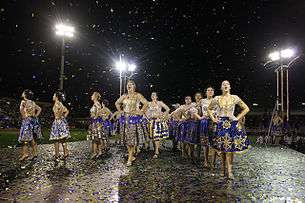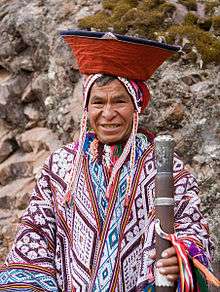Folk costume
A folk costume (also regional costume, national costume, or traditional garment) expresses an identity through costume, which is usually associated with a geographic area or a period of time in history. It can also indicate social, marital or religious status. If the costume is used to represent the culture or identity of a specific ethnic group, it is usually known as ethnic costume (also ethnic dress, ethnic wear, ethnic clothing, traditional ethnic wear or traditional ethnic garment). Such costumes often come in two forms: one for everyday occasions, the other for traditional festivals and formal wear.

| Part of a series on |
| Costume |
|---|
 |
|
Background
|
|
Society and culture |
|
Elements and methods |
|
Children |
|
Fictional |
|
Organizations |
|
People
|
|
Museums
|
Following the outbreak of romantic nationalism, the peasantry of Europe came to serve as models for all that appeared genuine and desirable. Their dress crystallised into so-called "typical" forms, and enthusiasts adopted that attire as part of their symbolism.
In areas where Western dress codes have become usual, traditional garments are often worn at special events or celebrations; particularly those connected with cultural traditions, heritage or pride. International events may cater for non-Western attendees with a compound dress code such as "business suit or national dress".
In modern times, there are instances where traditional garments are required by sumptuary laws. In Bhutan, the traditional Tibetan-style clothing of gho and kera for men, and kira and toego for women, must be worn by all citizens, including those not of Tibetan heritage. In Saudi Arabia, women are also required to wear the abaya in public.
Africa
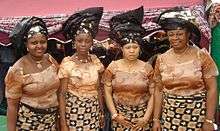
Central Africa
- Cameroon – Pagne (female), Toghu (male)
- Central African Republic – Pagne
- Democratic Republic of the Congo – Pagne
- Equatorial Guinea – Pano
- Gabon – Pagne
- Republic of the Congo – Pagne
- São Tomé and Príncipe – Pano
Eastern Africa
- Burundi – Imvutano
- Comoros – Lesso (female), Kanzu (male)
- Djibouti – Macawiis (male), Koofiyad (male), Dirac (female), Garbasaar (female)
- Eritrea – Kidan Habesha (male), Zuria or Habesha kemis (female)
- Ethiopia – Ethiopian suit or Kidan Habesha (male), Habesha kemis (female)
- Kenya – Kenya is unique among African nations in that it is the only country that does not have a national costume. All tribes have their respective traditional garments, for example: Maasai traditional costume: Kitenge, Kikoi, Maasai beadwork
- Madagascar – Lamba
- Mauritius – Sega dress
- Rwanda – Mushanana
- Seychelles – Kamtole dress
- Somalia – Macawiis (male), Koofiyad (male), Dirac (female), Guntiino (female), Garbasaar (female)
- Sudan – Jalabiyyah, Taqiyyah, and Turban (male), Toob, a cotton women's dress (female)
- Tanzania – Kanzu and Kofia (male), Kanga (female)
- Uganda – Kanzu and Kofia (male), Gomesi (female)
Northern Africa
- Algeria - Burnous, Caftan, Caftan El-Bey, Gandoura, Haïek, Jellaba, Mlaya, Sarouel
- Bikhmar (Ouargla)
- Blouza (Oran)
- Chedda (Tlemcen)
- Chemsa (Jijel)
- Fergani (Constantine)
- Gandoura Annabiya (Annaba)
- Ghlila, Karakou, Sarouel Mdawer (Algiers)
- Labsa M'zabia (M'zab)
- Labsa Naïlia (Ouled Naïl)
- Lefa we dlala (Annaba)
- Melhfa Chaouïa (Aures)
- Melhfa Sahraouia (Tindouf)
- Qashabiya (Djelfa et Laghouat), Labsa Kbaylia (Kabylie)
- Sétif – Binouar
- Labsa Touratia (Hoggar)
- Egypt – Galabeya
- Libya – Jellabiya, Farmla (an embroidered vest), Fouta
- Morocco – Djellaba, Fez hat and Balgha (male), Takchita (female)
- Sahrawi Arab Democratic Republic – Darra'a (male), Melhfa Sahraouia (female)
- Tunisia – Jebba, Chechia, Fouta
Southern Africa
- Angola – Pano
- Lesotho – Shweshwe clothing and blankets, Mokorotlo
- Malawi – Chitenje
- Mozambique – Capulana
- Namibia – Herero traditional clothing
- South Africa –
- Afrikaners and Rooineks: slouch hat, safari shirt, veldskoen, knee-high socks, khaki Bermuda shorts or trousers.
- Sotho: Shweshwe clothing and blankets, Mokorotlo
- Xhosa: Umbhaco
- Zulu: Zulu crown
- Zambia – Chitenje
- Zimbabwe – Chitenje
Western Africa
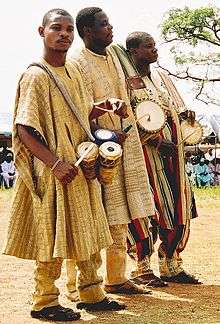
- Benin – Dashiki suit and Aso Oke Hat (male), Buba and wrapper set (female)
- Burkina Faso – Batakari (male), Kaftan (female)
- Cape Verde – Pano de terra
- Côte d'Ivoire – Kente cloth (male), Kente kaba and slit set (female)
- Gambia – Boubou (male), Kaftan (female)
- Ghana – Kente cloth or Ghanaian smock and Kufi (male), Kente kaba and slit set (female), Agbada (male)
- Guinea – Boubou (male), Kaftan (female)
- Guinea-Bissau – Ethnic clothes of Guinea-Bissau; for example: Fula: Boubou (male), Kaftan (female)
- Liberia – Dashiki suit and Kufi (male), Buba and skirt set (female)
- Mali – Grand boubou and Kufi (male), Kaftan (female)
- Mauritania – Darra'a (male), Melhfa Sahraouia (female)
- Niger – Babban riga, Tagelmust, Alasho (male), Kaftan (female)
- Nigeria – Agbada, Dashiki or Isiagu and Aso Oke Hat (male), Buba and wrapper set (female)
- Senegal – Senegalese kaftan and Kufi (male), Kaftan (female)
Asia
Central Asia
- Kazakhstan – Chapan, Kalpak (male), Saukele, Koylek (female)
- Kyrgyzstan – Chapan, Kalpak (male), Saukele, Koylek (female)
- Tajikistan – Chapan
- Turkmenistan – Chapan
- Uzbekistan – Khalat, Tubeteika, Chapan
East Asia
- China – Chinese clothing. Each ethnic groups of China have their own traditional costume.
- Japan – Kimono, Junihitoe, Sokutai
- Fukuoka Prefecture - Mizu happi and fundoshi
- Hokkaido - Ainu clothing
- Korea – Hanbok (South Korea)/Chosŏn-ot (North Korea)
- Mongolia – Deel
- Tibet – Chuba
- Taiwan -
- Han Taiwanese - Tangzhuang
- Taiwanese Aborigines - Aboriginal groups in Taiwan conserve traditional indigenous styles; popular styles include Amis, Atayal, Bunun and Paiwan styles.
North Asia
- Russia (Urals, Siberian Federal District and Far Eastern Siberia)- Clothing of Siberian nationalities (Buryat, Yakut, Altai, etc.)
South Asia
- Afghanistan – Pashtun dress: Afghan cap, turban, Shalwar Kameez (male), Firaq partug, Chador (veil) (female)
- Bangladesh – Sherwani and Kurta (male) and Sari (female)
- Bhutan – Gho (male) and Kira (female)
- India – Achkan, Shalwar Kameez, Sherwani, Dhoti, Phiran, Churidar, Kurta, Turban (male) and Sari, Patiala salwar, Lehenga, Choli, Pathin (female)
- Maldives – Dhivehi libaas (women) and Dhivehi mundu (men)
- Nepal – Daura-Suruwal and Dhaka topi, (male) and Gunyou Cholo (female); Traditional Newar, Sunuwar, Rai, Limbu ([bakku, chuwa])clothing
- Pakistan – Peshawari turban, Shalwar Kameez, Churidar (male), Shalwar Kameez and Dupatta (female)
- Sri Lanka – Kandyan sari (female)
Southeast Asia
._(2517376127).jpg)
- Brunei – Baju Melayu, Songkok (male), Baju Kurung, Tudung (female)
- Cambodia – Sampot, Apsara, Sabai, Krama, Chang kben
- East Timor – Tais cloth clothing
- Indonesia – (See: National costume of Indonesia). There are hundreds of types of folk costumes in Indonesia because of the diversity in the island nation. Each ethnic group of Indonesia have their own traditional costume;
- Batak tribe: Ulos
- Javanese people: Beskap, Batik shirt, Blangkon, Songkok, Sarong (male), Kebaya, Tudung, Sarong (female).
- Malay people: Baju Melayu, Baju Kurung, Songket
- Papua: Koteka
- etc.

- Laos – xout lao, suea pat, pha hang, pha biang, sinh
- Malaysia – Baju Melayu and Songkok (male), Baju Kurung, Baju Kebarung (Kebaya/Kurung hybrid), Tudung (female)
- Myanmar – Longyi, Gaung baung
- Philippines – Barong (male) and Baro't saya; Maria Clara gown, Terno (female), Malong, Patadyong, Tapis
- Singapore:
- Chinese Singaporeans - Hanfu, Cheongsam (female), Tangzhuang (male),Changpao (male)
- Indian Singaporeans - Sari (Female), Dhoti (Male), Kurta
- Malay Singaporeans - Baju Melayu (Male), Baju Kurung (female), Sarong
- Peranakans - Kebaya (female), Baju Lokchuan (male)
- Thailand – Chut thai: Thai female: Thai Chakkri, Thai male: Suea Phraratchathan, Both genders: Chong kraben and Sabai.
- Vietnam – Áo giao lĩnh, Áo dài, Áo tứ thân, Áo bà ba.
West Asia
- Armenia – Armenian dress, Arkhalig, Chokha
- Azerbaijan – Azerbaijani traditional clothing: Arkhalig, Chokha, Kelaghayi
- Bahrain – Thawb
- Israel – Tembel hat, Biblical sandals, Yemenite Jewish clothes; Jewish religious clothing: Rekel, Bekishe, Tzitzit, Kippah, Tichel.
- Iran – Chador, Turban, Kurdish clothing, minority traditional clothes: Qashqai, Azerbaijani, Gilaki and Turkmen clothing.
- Iraq – Assyrian clothing, Keffiyeh, Hashimi Dress, Bisht, Dishdasha; Kurdish clothing in Iraqi Kurdistan.
- Jordan – Keffiyeh, Bisht, Bedouin clothing
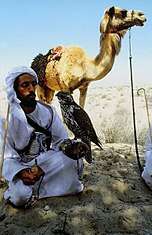 Modern Bedouin from Saudi Arabia with turban and jambiya dagger
Modern Bedouin from Saudi Arabia with turban and jambiya dagger - Lebanon – Tantour, Keffiyeh, Labbade, Taqiyah
- Kurdistan – Sirwal (pants), Kurdish clothing, gold coin belt and necklace for women.
- Kuwait – Thawb
- Oman – Dishdasha
- Palestine – Keffiyeh, Palestinian costumes.
- Qatar – Kandura
- Saudi Arabia – Thawb, Ghutrah, Agal, Bisht, Abaya, Jilbab, Niqab
- Syria – Dishdasha, Sirwal, Taqiyah, Keffiyeh
- Turkey – Fez, Kaftan, Shalvar.
- United Arab Emirates – Kandura, Abaya
- Yemen – Similar to Saudi Arabia, but with the addition of an ornate jambiya and leather bandoliers for the men's costume.
Europe
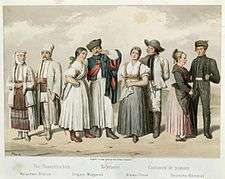
.jpg)

| Part of a series on |
| Western dress codes and corresponding attires |
|---|
|
|
|
Casual (anything not above) |
|
Supplementary alternatives
|
|
Legend: |
Eastern Europe
- Belarus – Slutsk stash, the national type of wimple (namitka)
- Georgia – Chokha (Every region has its own specific design of Chokha), Papakha
- Ossetia – Chokha
- Russia – Sarafan, Kokoshnik, Kosovorotka, Ushanka, Valenki; (Sami) Gákti, Luhkka for colder weather
- Ukraine – National costumes of Ukraine: Vyshyvanka, Sharovary, Żupan, Ukrainian wreath
Central Europe
- Austria - Tracht - Dirndl - Lederhosen
- Czech Republic – Kroje
- Hungary – National costumes of Hungary
- Poland – Żupan, Kontusz, Rogatywka (National costumes of Poland)
- Slovakia – Kroj (embroidered traditional dress)
Northern Europe
- Denmark – Folkedragt
- Faroe Islands – Føroysk klæði
- Greenland – Parka
- Estonia – Rahvariided[1]
- Finland – Every region has its own specific design of national costume (kansallispuku, nationaldräkt). These vary widely. Many of them resemble Swedish costumes, but some take influences from Russian costumes as well. For the Sami in Finland, each place has its own Gákti or Luhkka for colder weather.
- Iceland – Þjóðbúningurinn
- Ireland – Aran sweater, Irish walking hat, Grandfather shirt, Leine, Irish stepdance costume
- Latvia - Tautastērps
- Lithuania - Tautinis kostiumas
- Norway – Bunad, Sami: Gákti, and for colder weather, Luhkka
- Sweden – Sverigedräkten has varied from region to region but since 1983 has an official National Costume in one common version; 18th century: Nationella dräkten; Sami: Gákti, Luhkka for colder weather
- United Kingdom:
- England – English country clothing, Morris dance costumes, Flat cap, English clogs
- Cornwall – Sou'wester hat, fisherman's smock, gansey, bal-maiden clothing, Cornish kilts and tartans.
- London – Pearly kings and queens
- Northumbria - Maud, Border tartan, Northumbrian tam, blue bonnet, Rapper dance costumes
- Northern Ireland: Similar to Ireland.
- Scotland – Highland dress: Kilt or trews, tam o'shanter or Balmoral bonnet, doublet, Aboyne dress, and brogues or ghillies.
- Wales – Traditional Welsh costume
- England – English country clothing, Morris dance costumes, Flat cap, English clogs
Southern Europe
- Albania – Albanian Traditional Clothing
- Andorra – Barretina, espadrilles
- Bulgaria – Every town has its own design of a national costume (nosia), with different types of clothing items traditional for each of the ethnographic regions of the country.[2][3]
- Croatia – Croatian national costume, Lika cap, Sibenik cap
- Greece – Fustanella, Amalia costume; Ancient Greek clothing: Peplos, Chiton.
- Greek fisherman's caps in many coastal villages by the Aegean sea.
- Italy – Italian folk dance costumes; Roman clothing: Toga, Stola
- South Tyrol – Tracht and Dirndl
- Sardinia – Every town has its design of the traditional folk costume (see also Sardinian people for more information).
- Sicily – Coppola, Arbereshe costumes
- Malta – Għonnella
- Montenegro – Montenegrin cap
- North Macedonia – Macedonian national costume
- Portugal – Every region has its own specific design of a national costume.
- Romania – Romanian dress
- Serbia – Every region has different design of a national costume. Serbian traditional clothing, Lika cap, Montenegrin cap, Opanci, Šajkača, Šubara
- Kosovo – Traditional clothing of Kosovo
- Slovenia – Gorenjska noša (Upper Carniola)
- Spain – Every autonomous region has its own national costume.
- Andalusia - Sombrero cordobes, traje de flamenca, traje de luces, montera
- Basque Country – Beret, espadrilles
- Catalonia - Barretina, Faixa
- Galicia - Each province has its regional costume. A hat akin to a witch hat is worn in rural areas.
Western Europe
- Belgium – Bleu sårot
- France – Every region has its own specific design of national costume. The most famous French traditional clothing could be the Breton costume or the Alsatian costume; commonly associated French items of clothing are the beret and the Breton shirt.
- Germany – Every state has its own specific design of a national costume. For example, Bavaria's well-known Tracht: Lederhosen and Dirndl.
- Liechtenstein – Tracht, Dirndl
- Netherlands – Many Areas, Villages and Towns still have their traditional style of clothing; the more popular items of clothing are the Dutch woman’s bonnet and klompen.
- Switzerland – Every canton has its own specific design of a national costume.
North America
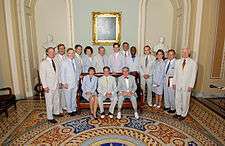
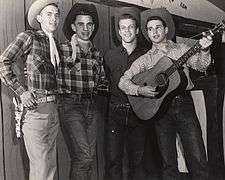
Caribbean
- Bahamas - None, unofficially Androsia-cloth clothing. Junkanoo costumes can be considered folk costume but fall more into the sector of carnival dress than traditional garment.
- Cuba – Guayabera, panama hat (male), guarachera[4] (female)
- Dominican Republic – Chacabana
- Dominica – Madras
- Haiti – Karabela dress (female), Shirt jacket (male)
- Jamaica – Bandanna cloth Quadrille dress (female), Bandanna cloth shirt and white trousers (male), Jamaican Tam
- Puerto Rico – Guayabera, panama hat (male), enaguas[5] (female)
- St. Lucia – Madras
- Trinidad and Tobago – Tobago has an Afro-Tobagonian Creole culture with the Bélé costumes as their typical garment, commonly made of madras. Trinidad, however, has no defined national garment; the two major ethnic groups in the island wear the following during cultural occasions:
- Afro-Trinidadians - Shirt jacket or Dashiki (male), Booboo (female)
- Indo-Trinidadian - Kurta, Dhoti, Sherwani (male), Sari, Choli, Lehenga (female)
Central America
Northern America
- Bermuda – Bermuda shorts
- Canada:
- Alberta - Canadian tuxedoes (denim jacket with denim shirt and blue jeans) and western wear are common on folk events such as the Calgary Stampede. They’re often worn with Calgary White Hats.
- First Nations – button blanket, buckskins, moccasins, Chilkat blanket, Cowichan sweater, war bonnet. The use of the term costume to denote traditional dress may be considered derogatory in First Nations communities. Regalia is the preferred term.
- Lumberjacks – Traditional logging wear includes mackinaw jackets or flannel shirts, with headgear being a tuque or trapper hat; a good example is seen with folk characters like Big Joe Mufferaw.
- Maritimes – Acadians wear their traditional heritage clothing on special occasions like the Tintamarre. The Scottish background in Nova Scotia has brought the Nova Scotia tartan as folk wear in the form of kilts, aboyne dresses and trews for Scottish highland dance competitions.
- Métis – Ceinture fléchée, Capote, Moccasins
- Newfoundland - Traditional mummers dress in masks and baggy clothes in Christmas season celebrations; the Cornish influence has also brought yellow oilskins and sou'westers as typical wear in coastal areas.
- Nunavut and other Inuit communities – Parka, mukluks, amauti
- Quebec and French Canadians – Ceinture fléchée, Capote, tuque
- Mexico – Charro outfit, Sarape, Sombrero (male), Rebozo, China Poblana dress (female); every state has a typical folk dress, for example:
- Chiapas - Chiapaneca
- Chihuahua and Coahuila – cowboy hats, cowboy boots, bandanna
- Oaxaca: Tehuana
- Querétaro, Hidalgo and San Luis Potosí - Quechquemitl
- Sonora - Yaqui or Seri clothes; Sonora is unique among Mexican states to not have a representative costume, yet the indigenous clothing, especially the Deer dance costume of the Yaqui, is very popular.
- Tamaulipas Cuera tamaulipeca
- Veracruz - Guayabera
- Yucatán – Guayabera (male), Huipil (female)
- United States:
- Alaska – Kuspuks, worn with dark pants and mukluks, as well as parkas are traditional native wear.
- American Southwest, Texas and rural areas in the Midwestern and Western US – Western wear, derived from original Mexican vaquero and American pioneer garb is traditional dress in Texas, the Southwestern US, and many rural communities, including cowboy hats, Western shirts, cowboy boots, jeans, chaps, prairie skirts, and bolo ties.
- American Upper Midwest, Pacific Northwest, the northern portions of the Great Lakes Basin and northern New England (especially Maine) – Due to the cold weather, the garb in rural areas tends to more closely adhere to heavier materials, such as flannel or Buffalo plaid mackinaw jackets, the occasional parka, and a knit cap or trapper hat. A good example is seen in the typical attire of Paul Bunyan, a folk hero popular in areas where logging was a common occupation, as well as lumberjacks working in the area.
- Amish (notably in Pennsylvania, Indiana and Ohio), the Pennsylvania Dutch and some sects of Mormon fundamentalism (especially in Utah) preserve traditional 19th century clothing styles.
- Deep South – Traditional Southern wear includes seersucker suits for men, and sun hats and large Southern belle-style dresses for women. Seersucker suits are also commonplace in the District of Columbia on Seersucker Thursday.
- The Cajun people of Louisiana traditionally wear the colorful capuchon for Mardi Gras celebrations.
- Gullah communities in the South Carolina Lowcountry and Sea Islands preserve the traditional African-style clothing and culture.
- Nantucket – Summer residents of Nantucket will often wear Nantucket Reds.
- Various styles of Native American clothing; for example, traditional pow-wow regalia for Plains Indians: Moccasins, buckskins, glass beads, breech clouts, and war bonnets or roaches. The use of the term costume to denote traditional dress may be considered derogatory in Native American communities. Regalia is the preferred term.
- New York City – According to folklorist Washington Irving, knickerbockers similar to the breeches of the Pilgrims and Founding Fathers were traditionally worn by many wealthy Dutch families in 19th century New York. These short pants remained commonplace among young urban American boys until the mid 20th century.
Oceania
Australia and New Zealand
- Australia
- Aboriginal Australians: fibercraft-made clothing, possum cloak
- European Australians: cork hat, bushwear: Moleskin trousers, bush shirt, Akubra slouch hat, Driza-Bone coat, Australian work boots
- Torres Strait Islands – Augemwalli
- New Zealand
- Māori – Māori Flax Skirts
- New Zealand Europeans - Swanndri bush jacket, slouch hat, walk shorts, knee-high socks
Melanesia
- Fiji – Sulu, Tapa cloth (called masi), I-sala
- New Caledonia – Manou, Robes mission
- Papua New Guinea – Meri blaus, lap-lap, Koteka
- Vanuatu – Aelan dress, Lap-lap
Micronesia
- Federated States of Micronesia - Lap-lap (male), Grass skirt (female)
- Palau - Lap-lap (male), Grass skirt (female)
Polynesia
- Cook Islands – Pareo
- French Polynesia – Pareo
- Hawaii – Aloha shirt, Muumuu, Holokū, Pāʻū, Malo (loincloth)
- Samoa – Lavalava, Puletasi, 'ie toga clothing
- Tonga – Tupenu, Ta'ovala, Tapa cloth
South America
- Argentina – Gaucho costume
- Bolivia – Poncho, Chullo, Andean pollera
- Brazil – Each region has its own traditional costume.
- Bahia – Baiana and Abadá
- Brazilian carnival or Samba costumes for Rio de Janeiro.
- Caipiras (Brazilian country folk) in Sao Paulo, Goiás and other nearby states conserve traditional folk styles of clothing, imitated by participants of festa juninas.
- Gaúcho costumes for Rio Grande Do Sul.
- Indigenous clothes for many states within the Amazônia Legal area
- Northeastern sertão (desert) – Vaqueiro or Cangaceiro clothing
- Chile – Huaso costume: Chamanto, Chupalla
- Colombia – Sombrero Vueltiao, ruana, white shirt, trousers and alpargatas (male), blouse, Cumbia pollera, Sombrero vueltiao and alpargatas (female); every region has a distinct costume.
- Ecuador – Poncho, Panama hat
- Guyana - Guyana is unique among South American nations to not have a designated style of national dress. Their two major ethnic groups wear the following during cultural events or important occasions:
- Afro-Guyanese - Dashiki or Shirt jacket (male), Booboo (female)
- Indo-Guyanese - Kurta, Sherwani, Churidar (male), Sari, Lehenga (female)
- Paraguay – Ao po'i
- Peru – Chullo, Poncho, Andean pollera
- Suriname – Kotomisse, Pangi cloth
- Uruguay – Gaucho costume
- Venezuela – Llanero costume (Liqui liqui and pelo e' guama hat; men), Joropo dress (women)
Notes
| Wikimedia Commons has media related to National costumes. |
- http://www.estonica.org/en/Culture/Traditional_folk_culture/Folk_costume/
- "Носиите – Жеравна 2014". Nosia.bg. 2013-06-16. Retrieved 2014-08-27.
- "Български народни носии – България в стари снимки и пощенски картички". Retrobulgaria.com. Retrieved 2014-08-27.
- Condra, Jill, ed. (2013). Encyclopedia of National Dress, Vol. I. Santa Barbara, CA: ABC-CLIO. p. 123.
- Condra, Jill, ed. (2013). Encyclopedia of National Dress, Vol. I. Santa Barbara, CA: ABC-CLIO. p. 123.
